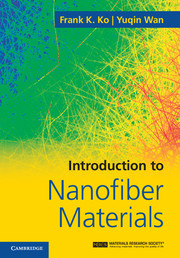Book contents
- Frontmatter
- Contents
- Foreword
- 1 Introduction
- 2 Fundamentals of polymers
- 3 Nanofiber technology
- 4 Modeling and simulation
- 5 Mechanical properties of fibers and fiber assemblies
- 6 Characterization of nanofibers
- 7 Bioactive nanofibers
- 8 Electroactive nanofibers
- 9 Nanocomposite fibers
- 10 Future opportunities and challenges of electrospinning
- Appendix I Terms and unit conversion
- Appendix II Abbreviation of polymers
- Appendix III Classification of fibers
- Appendix IV Polymers and solvents for electrospinning
- Index
- References
4 - Modeling and simulation
Published online by Cambridge University Press: 05 July 2014
- Frontmatter
- Contents
- Foreword
- 1 Introduction
- 2 Fundamentals of polymers
- 3 Nanofiber technology
- 4 Modeling and simulation
- 5 Mechanical properties of fibers and fiber assemblies
- 6 Characterization of nanofibers
- 7 Bioactive nanofibers
- 8 Electroactive nanofibers
- 9 Nanocomposite fibers
- 10 Future opportunities and challenges of electrospinning
- Appendix I Terms and unit conversion
- Appendix II Abbreviation of polymers
- Appendix III Classification of fibers
- Appendix IV Polymers and solvents for electrospinning
- Index
- References
Summary
A key objective in electrospinning is generating fibers of nanoscale diameter consistently and reproducibly. Considerable effort has been devoted to understanding how the parameters affect the spinnability and more specifically the diameter of the fibers resulting from the electrospinning process. Many processing parameters that influence the spinnability and the physical properties of nanofibers have been identified. These parameters include process parameters such as electric field strength, flow rate and spinning distance, spinning dope properties including concentration, viscosity and surface tension, etc., the spinning environment factors like humidity and the spinning setup factors such as the diameter of the orifice and the electrospinning angle. Through observation of the electrospinning process and analyzing these parameters, some governing models have been built and simulations of the motion of jet have been carried out. In this chapter, several main existing models and simulation works will be introduced to help readers gain an understanding of the concept of electrospinning.
Electrospinning mechanism
For a long time, the mechanism of electrospinning for forming nanoscaled fibers was believed to be a result of a “split” as seen by the naked eye (Fig. 4.1a). The “splitting” is explained by Doshi and Reneker [1, 2] that, as the jet diameter decreases, the surface charge density increases, resulting in high repulsive forces which split the jet into smaller jets splay. When a high-speed camera was used in the investigation of electrospinning jet, unstable bending, also known as “whipping” of jet, was observed, and the “bending instability” started being widely accepted as the electrospinning mechanism, as shown in Fig. 4.1b. As described [3, 4], the electrospun jet vigorously bent spirally and stretched inside a conical envelope resulting in a huge stretch ratio and a nanoscale diameter.
Information
- Type
- Chapter
- Information
- Introduction to Nanofiber Materials , pp. 64 - 79Publisher: Cambridge University PressPrint publication year: 2014
